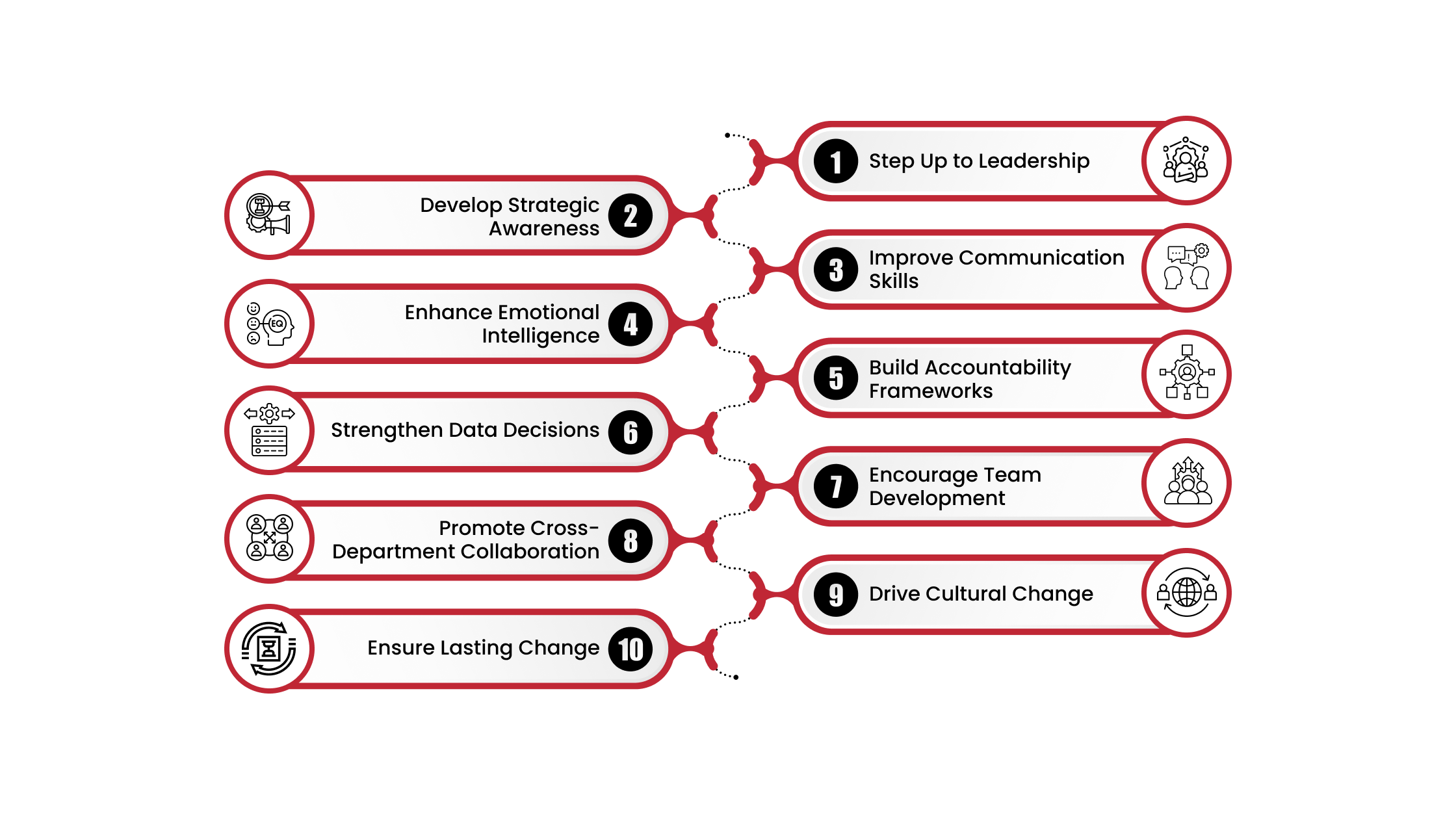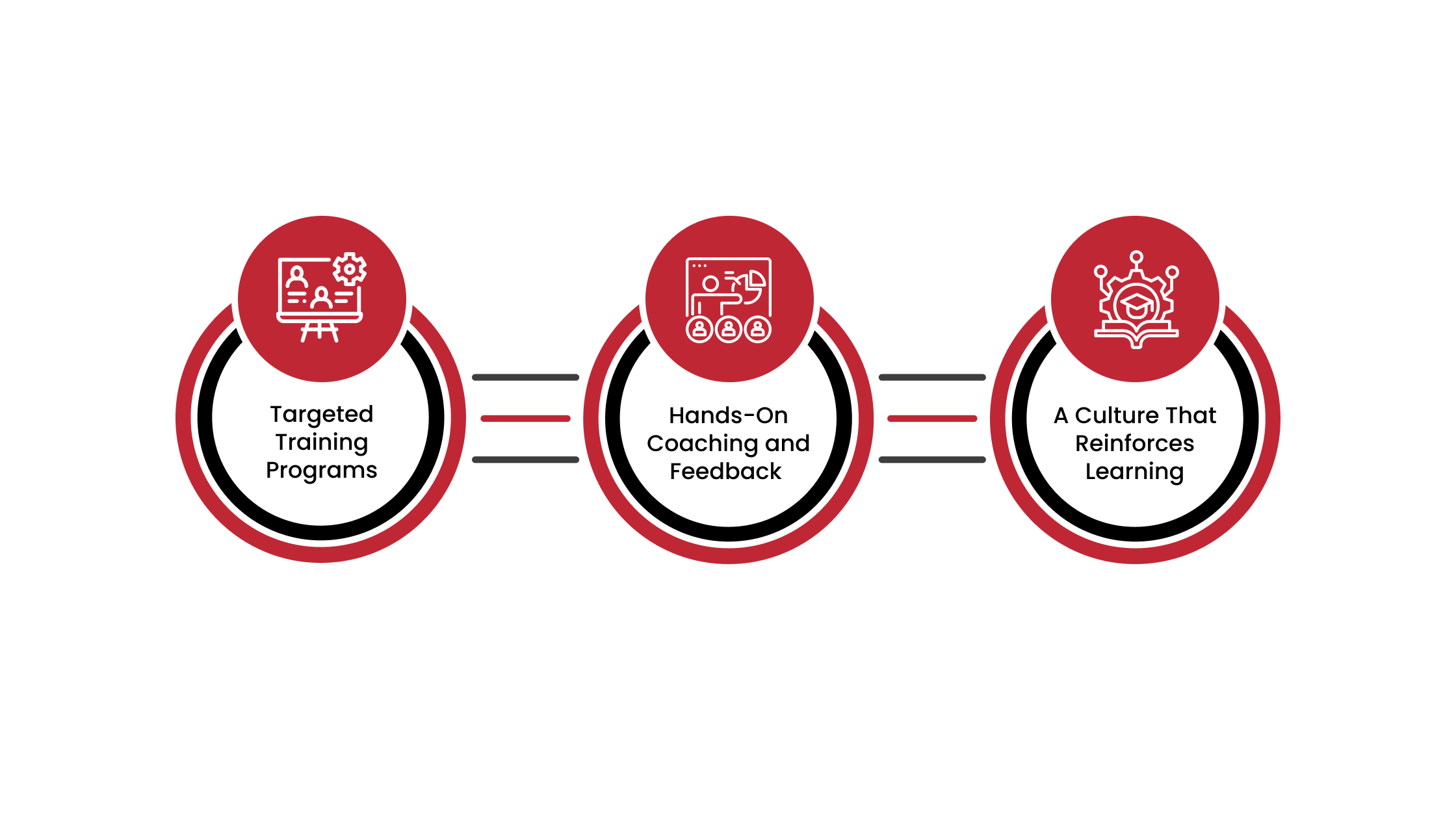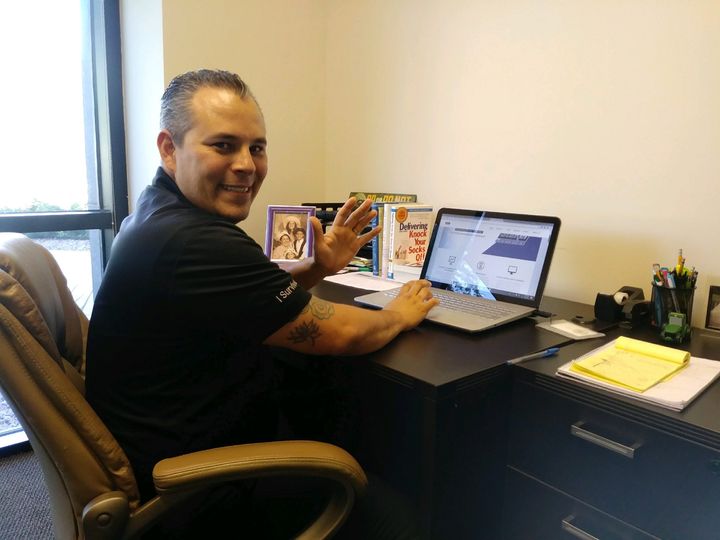How Does In-Dealership Training Transform Service Managers into Leaders?

Service departments are critical profit centers. Yet profitability and customer satisfaction depend heavily on the leadership quality of the service manager. When service managers lack leadership capabilities, the department risks high turnover, inconsistent customer experiences, and stagnant performance.
According to reports, 86% of leaders believe that developing new leaders is an urgent priority. For dealerships, this translates into stronger customer retention, more consistent profitability, and a motivated service team that remains engaged over the long term.
This is where in-dealership training makes the difference: it develops the leadership capabilities that service managers need to move beyond task execution and into actual organizational influence.
Top 10 Ways In-Dealership Training Builds Leadership Strength

In-dealership training shapes service managers into leaders by combining real-world practice with targeted coaching. It helps them grow beyond operational oversight and equips them to lead people, processes, and strategy effectively. Here are ten ways training builds lasting leadership strength.
1. Step Up to Leadership
Most service managers excel at managing tasks, including scheduling jobs, resolving problems, and maintaining smooth operations. Training goes further by helping them think like leaders, not just supervisors. Managers learn how to align their department with dealership strategy, focus on growth, and inspire their teams to achieve higher standards.
Major outcomes include:
- Moving from short-term task execution to long-term planning
- Shifting from directing employees to inspiring performance
- Developing confidence to influence dealership-wide decisions
2. Develop Strategic Awareness
An operational focus can leave managers stuck in a reactive mode. Training introduces methods to anticipate challenges, analyze market trends, and plan effectively. Service managers become capable of forecasting needs, preparing for seasonal demand, and aligning department objectives with the dealership’s growth strategy.
Practical elements include:
- Forecasting technician staffing and labor hours
- Planning for parts availability during peak periods
- Linking service goals with dealership financial objectives
3. Improve Communication Skills
Effective leadership requires straightforward, adaptable, and motivating communication. Training sharpens a manager’s ability to communicate effectively with technicians, advisors, executive managers, and customers in ways that foster clarity and trust. Managers learn how to set clear expectations, resolve misunderstandings promptly, and inspire confidence in every interaction.
Focus areas include:
- Tailoring communication to different audiences (staff, peers, leadership, customers)
- Using coaching conversations instead of one-way instructions
- Learning conflict resolution techniques to defuse tension
4. Enhance Emotional Intelligence
Service departments are high-pressure environments, often leading to stress and conflict. Training builds emotional intelligence, enabling managers to recognize stress in their teams, remain calm under pressure, and address customer concerns with empathy. These skills strengthen loyalty and build credibility.
Major benefits include:
- Reading emotional cues in staff and customers
- Handling disputes with patience and professionalism
- Building trust through empathy and fairness
5. Build Accountability Frameworks
A hallmark of strong leadership is the ability to hold teams accountable while maintaining respect. Training equips managers with tools to set performance standards, monitor KPIs, and provide balanced feedback that encourages improvement.
Managers learn how to:
- Establish clear goals and measurable performance indicators
- Conduct consistent performance reviews with fairness
- Balance recognition with corrective feedback
6. Strengthen Data Decisions
Service departments produce detailed performance data, but not all managers know how to use it effectively. Training helps managers analyze KPIs like effective labor rate, repair order averages, and customer satisfaction scores, then make decisions backed by evidence rather than guesswork.
Examples include:
- Identifying patterns in technician efficiency
- Pinpointing bottlenecks in service workflows
- Using CSI feedback to adjust customer service processes
7. Encourage Team Development
Leaders are defined by the growth of the people they lead. In-dealership training emphasizes coaching rather than directing, teaching managers to conduct effective one-on-ones, identify training needs, and build personalized growth plans for staff. This creates a motivated workforce and reduces costly turnover.
Training emphasizes:
- Setting individual development goals with advisors and technicians
- Creating succession plans for future leadership roles
- Recognizing and rewarding progress
8. Promote Cross-Department Collaboration
Departments in a dealership often work in silos, which limits efficiency and customer satisfaction. Training teaches service managers how to collaborate with sales, finance, and parts to create smooth, integrated customer experiences. Leaders who bridge these gaps ensure dealership-wide alignment.
Major collaboration practices:
- Coordinating with sales for service retention strategies
- Aligning with finance on warranty processes
- Working with parts to improve inventory flow
9. Drive Cultural Change
Culture defines how teams behave when leaders aren’t watching. Training helps managers establish cultures built on accountability, continuous learning, and a customer-focused approach. Leaders learn to model the behaviors they expect, creating ripple effects across the team.
Core cultural improvements include:
- Building a culture of respect and professionalism
- Promoting continuous process improvement
- Encouraging staff to contribute ideas for better workflows
10. Ensure Lasting Change
Many training programs fade quickly, but in-dealership training ensures habits stick. Because managers practice leadership skills in their actual work environment, improvements become part of daily behavior rather than temporary takeaways.
Sustainable outcomes:
- New leadership behaviors are applied immediately in real settings
- Ongoing reinforcement through follow-up modules and coaching
- Long-term growth that benefits both managers and dealerships
The Measurable Impact of Leadership Training
Dealerships that invest in developing service leaders see tangible results. Senior management training enhances clarity in goal-setting, ensures consistent customer experiences, and fosters overall team alignment. Within service departments, this translates into:
- Higher technician productivity and efficiency
- Improved repair order averages and gross profit per RO
- Stronger CSI and customer retention rates
- Reduced turnover among advisors and technicians
- A leadership pipeline prepared for future dealership growth
In other words, in-dealership training is a high-ROI investment in dealership performance and sustainability.
Core Elements of Service Leadership Development

Effective leadership development inside dealerships depends on more than experience in the service drive. It requires intentional structure, personalized support, and an environment where learning is valued and applied.
1. Targeted Training Programs
Leadership growth begins with structured training that focuses on the realities of a service department. ATN’s in-dealership training programs are devised to develop skills in areas such as strategic planning, performance management, and customer satisfaction. By addressing the daily challenges managers face, these programs create a clear pathway from operational management to leadership readiness.
2. Hands-On Coaching and Feedback
One-on-one coaching helps service managers transition from theory to practice. Trainers observe interactions, provide immediate feedback, and guide managers on how to improve communication, accountability, and decision-making. This personalized approach ensures that development aligns with individual strengths and closes specific gaps.
3. A Culture That Reinforces Learning
Leadership development cannot exist in isolation. Dealerships that support growth create environments where managers are encouraged to experiment, apply new techniques, and refine their approach.
Why ATN’s Approach Works
Leadership growth requires more than workshops or theory. It requires real-world practice reinforced by consistent learning. ATN’s in-dealership programs stand out because they blend live coaching with virtual reinforcement through ATNVT.
- Customization: Training tailored to each dealership’s challenges, team dynamics, and goals.
- Hands-On Coaching: Trainers model leadership behaviors live, from team huddles to customer interactions.
- Real-Time Feedback: Managers receive immediate guidance to refine their approach in real-time.
- Continuous Reinforcement: ATNVT supports long-term growth with interactive modules, quizzes, and certifications that keep skills sharp and up-to-date.
This combination of in-person immersion and on-demand virtual training ensures that leadership skills aren’t just learned. They’re practiced, tested, and sustained.
Start Building the Leadership Skills That Create Impact With ATN

Rising to the level of executive manager in a dealership demands vision, leadership, and the ability to bring every department, sales, service, and finance, into alignment around shared goals.
From the first role on the showroom floor to overseeing multi-million-dollar operations, each step in a career builds the foundation for success at the top. With the right mindset, continuous development, and proven results, service managers can grow into leaders who shape both their careers and the future of their dealerships.
The Automotive Training Network offers high-impact leadership programs developed for professionals preparing to assume executive responsibilities. These programs focus on developing the advanced skills required to drive profitability, strengthen culture, and deliver consistent customer satisfaction across all departments.
ATN’s Executive Manager Development Programs Include:
- Leadership and team-building techniques that align sales, service, and finance
- Advanced financial training on forecasting, profitability, and P&L management
- Sales, customer satisfaction, and reputation-building strategies
- Compliance, process optimization, and operational excellence modules
- Hands-on coaching with real-world dealership scenarios
Start leading with confidence. Partner with Automotive Training Network to prepare for the next level of dealership success. Begin your path toward becoming an effective executive leader.



